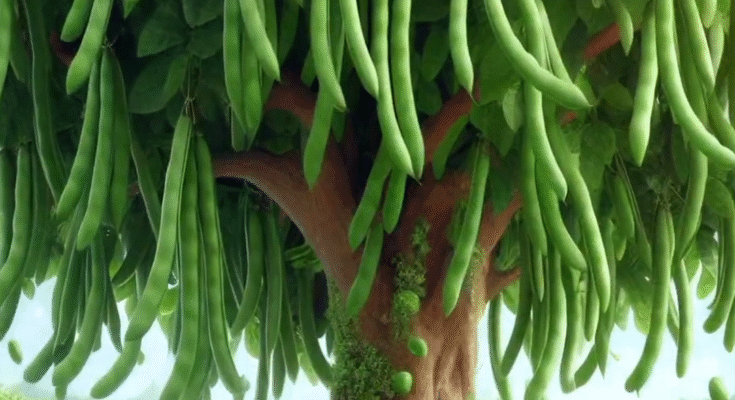Easy and Fast Technique for Planting and Growing Stick Bean Fruit Trees Using Stem Grafts
Growing fruit trees at home is both a rewarding and practical activity. Among the many fruit-bearing plants, the stick bean fruit tree stands out for its unique flavor, high nutritional value, and adaptability to various climates. While many people rely on seeds for propagation, this method can be slow and unpredictable. A faster and more reliable approach is stem grafting, a technique that allows you to cultivate stick bean fruit trees with greater efficiency and higher success rates. This article will guide you through an easy and fast technique for planting and growing stick bean fruit trees using stem grafts.
Why Choose Stem Grafting for Stick Bean Fruit Trees?
Stem grafting is the process of joining a branch or shoot (the scion) from a desired stick bean tree onto the stem of another plant (the rootstock). This method is widely used in fruit tree cultivation for several reasons:
- Faster Growth and Fruiting – Trees grown from grafts tend to establish more quickly and bear fruit sooner compared to seed-grown plants.
- Preservation of Desired Qualities – With grafting, you can replicate the exact taste, size, and quality of a parent stick bean fruit tree, ensuring consistency.
- Increased Disease Resistance – By choosing a hardy rootstock, you give your grafted stick bean tree better resilience against pests, diseases, and unfavorable soil conditions.
- Efficient Land Use – Stem grafting makes it possible to cultivate multiple varieties of fruit on a single tree, saving space in the garden.
Preparing for Stem Grafting
Before starting the grafting process, preparation is key to achieving success.
1. Selecting the Rootstock
Choose a healthy young stick bean tree or a compatible fruit tree that grows well in your soil. The rootstock should be disease-free, vigorous, and well-established.
2. Choosing the Scion
The scion should be a healthy stem from a mature stick bean tree that produces good-quality fruits. Select a young, pencil-thick branch with several buds for best results.
3. Tools and Materials
To perform stem grafting, you will need:
- A sharp grafting knife or blade
- Sterilizing alcohol or hot water to clean tools
- Grafting tape, budding tape, or plastic strips for wrapping
- Pruning shears
- A clean cloth or tissue
Step-by-Step Stem Grafting Technique
Here’s a simple and fast method for grafting stick bean fruit trees:
Step 1: Prepare the Rootstock
- Select a young rootstock about 1–2 years old with a stem thickness similar to your chosen scion.
- Cut the stem of the rootstock about 15–20 cm above the ground using a clean, sharp knife.
Step 2: Prepare the Scion
- Take the scion from a healthy stick bean tree and trim it to about 8–10 cm in length.
- Ensure it has at least 2–3 visible buds.
- Cut the bottom of the scion into a wedge shape so it fits neatly into the rootstock.
Step 3: Make the Graft Union
- On the rootstock stem, make a vertical slit about 3–4 cm deep.
- Insert the wedge-shaped scion into the slit, ensuring the cambium layers (the green tissue under the bark) of both scion and rootstock align.
Step 4: Secure the Graft
- Wrap the graft union tightly with grafting tape or plastic strip to prevent air and water from entering.
- Ensure the scion is firmly held in place.
Step 5: Protect the Graft
- Cover the grafted area with a plastic bag or protective sleeve to maintain humidity and reduce the risk of drying out.
- Place the grafted plant in a shaded area for a few weeks until the graft heals.
Caring for Grafted Stick Bean Trees
After grafting, proper care ensures the young plant grows strong and healthy.
1. Watering
Keep the soil moist but not waterlogged. Consistent watering is essential for the graft union to heal and for the young tree to thrive.
2. Sunlight
Once the graft begins to show signs of growth, gradually expose it to more sunlight. Stick bean fruit trees prefer full sun for healthy development.
3. Pruning
Remove any shoots or suckers growing from below the graft union. This ensures all nutrients go to the grafted scion instead of unwanted growth.
4. Fertilization
Apply a balanced organic fertilizer once the graft has successfully taken and the plant shows new leaves. Fertilize every 4–6 weeks to encourage strong root and stem development.
5. Pest and Disease Management
Check the young tree regularly for pests such as aphids or caterpillars. Use organic insecticides or natural repellents to protect the plant.
Advantages of Grafted Stick Bean Fruit Trees
By using stem grafting, gardeners can enjoy several benefits:
- Earlier Harvests – Grafted trees often begin bearing fruit in just 2–3 years.
- Higher Yield – Stronger root systems from grafting mean the tree produces more fruits.
- Better Adaptability – Grafted trees can be tailored to local soil and climate conditions.
- Consistent Quality – Fruits from grafted trees are uniform in taste, size, and appearance.
Conclusion
Growing stick bean fruit trees using stem grafts is one of the easiest and fastest ways to enjoy fresh, homegrown fruits. The technique not only speeds up the growth and fruiting process but also ensures the quality of your harvest remains consistent. With just a little practice and care, even beginners can master stem grafting and transform their gardens into productive spaces full of delicious stick beans.
If you are looking for a reliable way to expand your fruit garden and enjoy healthy harvests year after year, stem grafting is a technique worth trying. By following the steps outlined in this guide, you’ll be on your way to cultivating thriving stick bean fruit trees that will reward you with abundant yields for years to come.



